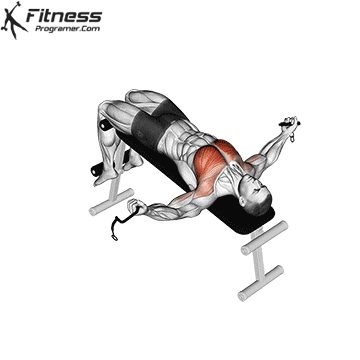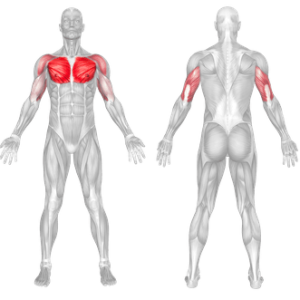Decline Cable Fly Overview
The Decline Cable Fly is an isolation exercise that targets the lower chest (sternal head of the pectoralis major). Performed using a cable machine, this movement allows for continuous tension on the muscles, leading to greater muscle activation and development. It’s an excellent addition to a chest workout routine for sculpting and defining the lower chest while also improving flexibility and muscle balance.
How to Decline Cable Fly

Setup
- Set the pulleys on a cable machine to a high position, above shoulder level.
- Attach D-handles to each cable.
- Stand in the middle of the cable machine with one handle in each hand.
- Lean your torso slightly forward and extend your arms out to the sides with a slight bend in the elbows.
Execution
- Starting Position:
- Begin with your arms extended to the sides, palms facing forward, and a slight bend in your elbows.
- Engage your core to stabilize your body.
- Contraction Phase:
- Pull the handles downward and inward in a wide arc, bringing your hands together in front of your hips.
- Squeeze your chest muscles at the bottom of the movement.
- Return Phase:
- Slowly reverse the motion, allowing your arms to return to the starting position.
- Maintain control to keep tension on the cables throughout.
- Repeat: Perform for the desired number of repetitions with smooth and controlled movements.
Tips for Maximum Effectiveness
- Focus on the Chest: Concentrate on squeezing your chest muscles during the contraction phase.
- Control the Eccentric Phase: Lower the cables slowly to maximize time under tension and stimulate muscle growth.
- Adjust the Pulleys Properly: Ensure the cables are set at an appropriate height to target the lower chest effectively.
- Breathe Correctly: Exhale as you pull the handles downward and inhale as you return to the starting position.
- Incorporate into a Balanced Routine: Pair with incline and flat chest exercises for comprehensive chest development.
Common Mistakes to Avoid
- Locking the Elbows: Keep a slight bend in your elbows to protect your joints and maintain proper form.
- Using Momentum: Avoid jerking the cables; focus on slow, controlled movements for maximum effectiveness.
- Incorrect Arm Path: Ensure your arms move in a downward arc, not straight up and down or side to side.
- Overarching the Back: Keep your core engaged to avoid excessive lower back strain.
- Setting Too Much Weight: Start with a manageable resistance to prioritize proper form over heavy loads.
Benefits of the Decline Cable Fly
- Lower Chest Development
- Specifically targets the lower chest for a well-rounded, defined chest appearance.
- Constant Tension
- The cables provide continuous resistance throughout the movement, enhancing muscle activation.
- Improved Muscle Definition
- Isolates the chest muscles, helping to sculpt and tone the lower chest area.
- Enhanced Range of Motion
- Allows for a deeper stretch at the top and a stronger contraction at the bottom of the movement.
- Joint-Friendly Exercise
- The controlled arc motion minimizes stress on the shoulder and elbow joints compared to heavy pressing movements.
- Versatility
- Suitable for lifters of all levels, as resistance can be easily adjusted.
- Balance and Symmetry
- Helps correct muscle imbalances by working each side independently.
Decline Cable Fly Muscles Worked

